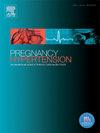Correlation between maternal hemodynamic and sFlt-1/PlGF ratio in pregnancies affected by hypertensive disorders and fetal growth restriction
IF 2.9
4区 医学
Q2 OBSTETRICS & GYNECOLOGY
Pregnancy Hypertension-An International Journal of Womens Cardiovascular Health
Pub Date : 2025-04-30
DOI:10.1016/j.preghy.2025.101214
引用次数: 0
Abstract
Objectives
Our aim was to investigate the correlation between maternal hemodynamic and sFlt1/PlGF ratio in different phenotypes of Hypertensive Disorders of Pregnancy and Fetal Growth Restriction.
Study design
We recruited high risk pregnancies for Hypertensive Disorders and Fetal Growth Restriction. Heart rate, cardiac output, total vascular resistance and myocardial wall relaxation were derived from transthoracic echocardiography. Doppler Velocimetry of uterine arteries and serum sFlt1/PlGF ratio were measured.
Main outcomes measures
The effect of maternal hemodynamic on the oxidative stress of the syncytiotrophoblast was proved by the significant correlation coefficient of the linear regression between sFlt-1/PlGF ratio with mean arterial pressure, heart rate, cardiac output, total vascular resistance, myocardial wall relaxation and uterine arteries’ pulsatility index, which showed the highest correlation coefficient.
Results
We identified 17 cases of Hypertensive Disorders of Pregnancy without Fetal Growth Restriction, 19 hypertensive patients with Fetal Growth Restriction, 25 cases of early Fetal Growth Restriction, 25 cases of late Fetal Growth Restriction and 16 controls. At univariate linear regression the sFlt-1/PlGF ratio significantly increased on average 85 times (+8549%) in case of hypertension associated with growth restriction, 17 times in case of isolated hypertension (+1681%), 6 times in early growth restriction (661%) and more than 5 times in the late form (542%). There was a correlation between sFlt-1/PlGF ratio and both uterine arteries’ pulsatility index (ρ=0.48) and mean arterial pressure (ρ=0.45).
Conclusions
There is a significant relationship between maternal hemodynamic and sFlt-1/PlGF ratio, confirming the different characteristics of patients affected by hypertension and/or fetal growth restriction.
高血压疾病和胎儿生长受限孕妇血液动力学与sFlt-1/PlGF比值的相关性
目的探讨妊娠期不同表型高血压疾病和胎儿生长受限患者血液动力学与sFlt1/PlGF比值的相关性。研究设计我们招募了高血压疾病和胎儿生长受限的高危孕妇。经胸超声心动图测定心率、心输出量、总血管阻力和心肌壁舒张。多普勒测定子宫动脉流速及血清sFlt1/PlGF比值。主要观察指标sFlt-1/PlGF比值与平均动脉压、心率、心输出量、总血管阻力、心肌壁舒张度、子宫动脉搏动指数线性回归的相关系数最高,证实母体血流动力学对合胞滋养细胞氧化应激的影响。结果无胎儿生长受限妊娠高血压病患者17例,合并胎儿生长受限高血压病患者19例,早期胎儿生长受限25例,晚期胎儿生长受限25例,对照组16例。单变量线性回归显示,合并生长受限的高血压患者sFlt-1/PlGF比值平均增加85倍(+8549%),孤立性高血压患者增加17倍(+1681%),早期生长受限患者增加6倍(661%),晚期生长受限患者增加5倍以上(542%)。sFlt-1/PlGF比值与两条子宫动脉搏动指数(ρ=0.48)和平均动脉压(ρ=0.45)有相关性。结论产妇血流动力学与sFlt-1/PlGF比值有显著关系,证实了高血压和/或胎儿生长受限患者的不同特征。
本文章由计算机程序翻译,如有差异,请以英文原文为准。
求助全文
约1分钟内获得全文
求助全文
来源期刊

Pregnancy Hypertension-An International Journal of Womens Cardiovascular Health
OBSTETRICS & GYNECOLOGYPERIPHERAL VASCULAR-PERIPHERAL VASCULAR DISEASE
CiteScore
4.90
自引率
0.00%
发文量
127
期刊介绍:
Pregnancy Hypertension: An International Journal of Women''s Cardiovascular Health aims to stimulate research in the field of hypertension in pregnancy, disseminate the useful results of such research, and advance education in the field.
We publish articles pertaining to human and animal blood pressure during gestation, hypertension during gestation including physiology of circulatory control, pathophysiology, methodology, therapy or any other material relevant to the relationship between elevated blood pressure and pregnancy. The subtitle reflects the wider aspects of studying hypertension in pregnancy thus we also publish articles on in utero programming, nutrition, long term effects of hypertension in pregnancy on cardiovascular health and other research that helps our understanding of the etiology or consequences of hypertension in pregnancy. Case reports are not published unless of exceptional/outstanding importance to the field.
 求助内容:
求助内容: 应助结果提醒方式:
应助结果提醒方式:


